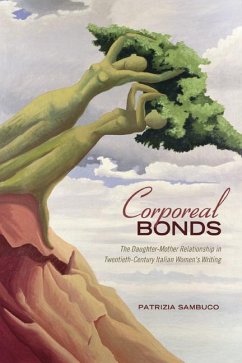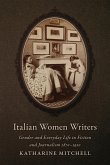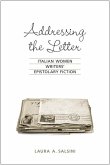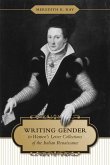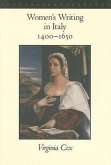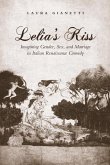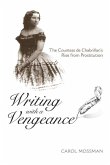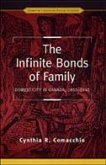Patrizia Sambuco
Corporeal Bonds
The Daughter-Mother Relationship in Twentieth-Century Italian Women's Writing
Schade – dieser Artikel ist leider ausverkauft. Sobald wir wissen, ob und wann der Artikel wieder verfügbar ist, informieren wir Sie an dieser Stelle.
Patrizia Sambuco
Corporeal Bonds
The Daughter-Mother Relationship in Twentieth-Century Italian Women's Writing
- Gebundenes Buch
- Merkliste
- Auf die Merkliste
- Bewerten Bewerten
- Teilen
- Produkt teilen
- Produkterinnerung
- Produkterinnerung
In Corporeal Bonds, Patrizia Sambuco analyses novels by authors such as Elsa Morante, Francesca Sanvitale, Mariateresa Di Lascia, and Elena Ferrante, each of which is narrated from the daughter’s point of view and depicts the daughter’s bond with the mother.
Andere Kunden interessierten sich auch für
![Italian Women Writers Italian Women Writers]() Katharine MitchellItalian Women Writers93,99 €
Katharine MitchellItalian Women Writers93,99 €![Addressing the Letter Addressing the Letter]() Laura A SalsiniAddressing the Letter59,99 €
Laura A SalsiniAddressing the Letter59,99 €![Writing Gender in Women's Letter Collections of the Italian Renaissance Writing Gender in Women's Letter Collections of the Italian Renaissance]() Meredith K RayWriting Gender in Women's Letter Collections of the Italian Renaissance78,99 €
Meredith K RayWriting Gender in Women's Letter Collections of the Italian Renaissance78,99 €![Women's Writing in Italy, 1400-1650 Women's Writing in Italy, 1400-1650]() Virginia CoxWomen's Writing in Italy, 1400-165063,99 €
Virginia CoxWomen's Writing in Italy, 1400-165063,99 €![Lelia's Kiss Lelia's Kiss]() Laura GiannettiLelia's Kiss93,99 €
Laura GiannettiLelia's Kiss93,99 €![Writing with a Vengeance Writing with a Vengeance]() Carol A MossmanWriting with a Vengeance55,99 €
Carol A MossmanWriting with a Vengeance55,99 €![The Infinite Bonds of Family The Infinite Bonds of Family]() Cynthia R ComacchioThe Infinite Bonds of Family80,99 €
Cynthia R ComacchioThe Infinite Bonds of Family80,99 €-
In Corporeal Bonds, Patrizia Sambuco analyses novels by authors such as Elsa Morante, Francesca Sanvitale, Mariateresa Di Lascia, and Elena Ferrante, each of which is narrated from the daughter’s point of view and depicts the daughter’s bond with the mother.
Produktdetails
- Produktdetails
- Verlag: University of Toronto Press
- Seitenzahl: 256
- Erscheinungstermin: 11. Juni 2012
- Englisch
- Abmessung: 231mm x 150mm x 23mm
- Gewicht: 476g
- ISBN-13: 9781442644250
- ISBN-10: 1442644257
- Artikelnr.: 36182350
- Herstellerkennzeichnung
- Libri GmbH
- Europaallee 1
- 36244 Bad Hersfeld
- gpsr@libri.de
- Verlag: University of Toronto Press
- Seitenzahl: 256
- Erscheinungstermin: 11. Juni 2012
- Englisch
- Abmessung: 231mm x 150mm x 23mm
- Gewicht: 476g
- ISBN-13: 9781442644250
- ISBN-10: 1442644257
- Artikelnr.: 36182350
- Herstellerkennzeichnung
- Libri GmbH
- Europaallee 1
- 36244 Bad Hersfeld
- gpsr@libri.de
Patrizia Sambuco is the editor of Transmissions of Memory and Italian Women Writers, 1800–2000 and the author of Corporeal Bonds.
Acknowledgments
Introduction
1 Psychoanalytic Accounts of Sexual Difference: Luce Irigaray and Italian
Feminism
The Denial of the Mother
The Mother Figure and the Maternal
Irigaray: Subjectivity and the Mother-Daughter Corporeal Bond
From Mothers to Daughters: The Italian Scene
Diotima and Luisa Muraro
Adriana Cavarero
2 Elsa Morante’s Menzogna e sortilegio: The Incorporeal Bond
Menzogna e sortilegio and the Critics
Motherhood and the Mother-Daughter Relationship: Cesira and Anna
Maternal Love: Rosaria and Alessandra
Elisa
3 Francesca Sanvitale’s Madre e figlia: Bodies of Pain and Imagination
Body as Object of Desire
The Male Hero
Medical Establishment: The Attack on the Body
Critique and Re-imagining
Writing, Imagination, and Language
Narrator, Character, and Author in Search of Identity
4 Mariateresa Di Lascia’s Passaggio in ombra: The Maternal as Expression of
Desire and Corporeality
Desire
Chiara
The Daughter within the Heterosexual Economy
Body and Knowledge
5 Elena Ferrante’s L’amore molesto: The Renegotiation of the Mother’s Body
Delia: The Love and Hatred of a Selfless Subject
Reconstructing the Past
The Language of Dresses
6 Elena Stancanelli’s Benzina: The Surreal Mother-Daughter Relationship and
New Possibilities
Elena Stancanelli and the Literary Scene, 1995–2000
Benzina 154
Mother and Daughter: Different Bodies, Different Personalities
A Relationship of Fusion and Independence
Oppressed Bodies in the Family Home
Looking, and Looking at Each Other
Conclusion
Notes
Bibliography
Index
Introduction
1 Psychoanalytic Accounts of Sexual Difference: Luce Irigaray and Italian
Feminism
The Denial of the Mother
The Mother Figure and the Maternal
Irigaray: Subjectivity and the Mother-Daughter Corporeal Bond
From Mothers to Daughters: The Italian Scene
Diotima and Luisa Muraro
Adriana Cavarero
2 Elsa Morante’s Menzogna e sortilegio: The Incorporeal Bond
Menzogna e sortilegio and the Critics
Motherhood and the Mother-Daughter Relationship: Cesira and Anna
Maternal Love: Rosaria and Alessandra
Elisa
3 Francesca Sanvitale’s Madre e figlia: Bodies of Pain and Imagination
Body as Object of Desire
The Male Hero
Medical Establishment: The Attack on the Body
Critique and Re-imagining
Writing, Imagination, and Language
Narrator, Character, and Author in Search of Identity
4 Mariateresa Di Lascia’s Passaggio in ombra: The Maternal as Expression of
Desire and Corporeality
Desire
Chiara
The Daughter within the Heterosexual Economy
Body and Knowledge
5 Elena Ferrante’s L’amore molesto: The Renegotiation of the Mother’s Body
Delia: The Love and Hatred of a Selfless Subject
Reconstructing the Past
The Language of Dresses
6 Elena Stancanelli’s Benzina: The Surreal Mother-Daughter Relationship and
New Possibilities
Elena Stancanelli and the Literary Scene, 1995–2000
Benzina 154
Mother and Daughter: Different Bodies, Different Personalities
A Relationship of Fusion and Independence
Oppressed Bodies in the Family Home
Looking, and Looking at Each Other
Conclusion
Notes
Bibliography
Index
Acknowledgments
Introduction
1 Psychoanalytic Accounts of Sexual Difference: Luce Irigaray and Italian
Feminism
The Denial of the Mother
The Mother Figure and the Maternal
Irigaray: Subjectivity and the Mother-Daughter Corporeal Bond
From Mothers to Daughters: The Italian Scene
Diotima and Luisa Muraro
Adriana Cavarero
2 Elsa Morante’s Menzogna e sortilegio: The Incorporeal Bond
Menzogna e sortilegio and the Critics
Motherhood and the Mother-Daughter Relationship: Cesira and Anna
Maternal Love: Rosaria and Alessandra
Elisa
3 Francesca Sanvitale’s Madre e figlia: Bodies of Pain and Imagination
Body as Object of Desire
The Male Hero
Medical Establishment: The Attack on the Body
Critique and Re-imagining
Writing, Imagination, and Language
Narrator, Character, and Author in Search of Identity
4 Mariateresa Di Lascia’s Passaggio in ombra: The Maternal as Expression of
Desire and Corporeality
Desire
Chiara
The Daughter within the Heterosexual Economy
Body and Knowledge
5 Elena Ferrante’s L’amore molesto: The Renegotiation of the Mother’s Body
Delia: The Love and Hatred of a Selfless Subject
Reconstructing the Past
The Language of Dresses
6 Elena Stancanelli’s Benzina: The Surreal Mother-Daughter Relationship and
New Possibilities
Elena Stancanelli and the Literary Scene, 1995–2000
Benzina 154
Mother and Daughter: Different Bodies, Different Personalities
A Relationship of Fusion and Independence
Oppressed Bodies in the Family Home
Looking, and Looking at Each Other
Conclusion
Notes
Bibliography
Index
Introduction
1 Psychoanalytic Accounts of Sexual Difference: Luce Irigaray and Italian
Feminism
The Denial of the Mother
The Mother Figure and the Maternal
Irigaray: Subjectivity and the Mother-Daughter Corporeal Bond
From Mothers to Daughters: The Italian Scene
Diotima and Luisa Muraro
Adriana Cavarero
2 Elsa Morante’s Menzogna e sortilegio: The Incorporeal Bond
Menzogna e sortilegio and the Critics
Motherhood and the Mother-Daughter Relationship: Cesira and Anna
Maternal Love: Rosaria and Alessandra
Elisa
3 Francesca Sanvitale’s Madre e figlia: Bodies of Pain and Imagination
Body as Object of Desire
The Male Hero
Medical Establishment: The Attack on the Body
Critique and Re-imagining
Writing, Imagination, and Language
Narrator, Character, and Author in Search of Identity
4 Mariateresa Di Lascia’s Passaggio in ombra: The Maternal as Expression of
Desire and Corporeality
Desire
Chiara
The Daughter within the Heterosexual Economy
Body and Knowledge
5 Elena Ferrante’s L’amore molesto: The Renegotiation of the Mother’s Body
Delia: The Love and Hatred of a Selfless Subject
Reconstructing the Past
The Language of Dresses
6 Elena Stancanelli’s Benzina: The Surreal Mother-Daughter Relationship and
New Possibilities
Elena Stancanelli and the Literary Scene, 1995–2000
Benzina 154
Mother and Daughter: Different Bodies, Different Personalities
A Relationship of Fusion and Independence
Oppressed Bodies in the Family Home
Looking, and Looking at Each Other
Conclusion
Notes
Bibliography
Index

